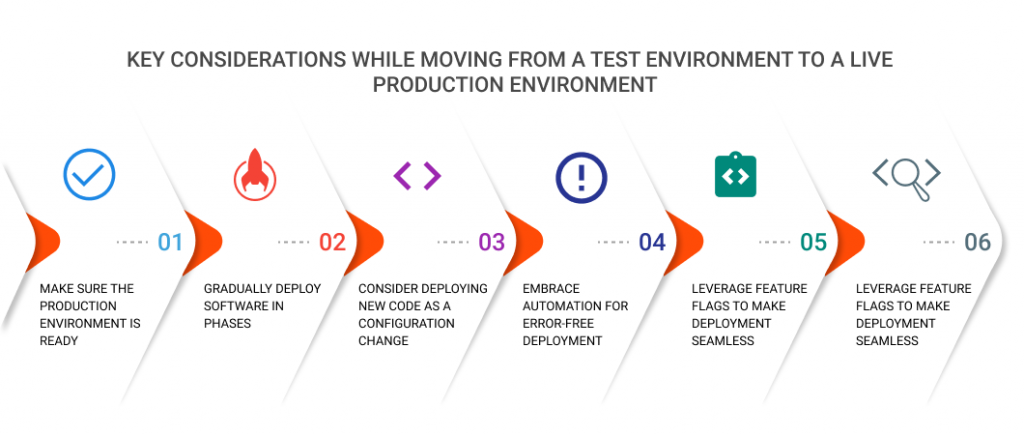Last updated on April 3rd, 2024
You’ve developed your software. You’ve run all the tests. Now it’s time to deploy your product from test environment to a live production environment. But you’re not sure if you’ve done everything you should have to ensure a successful deployment. Moving your product to a live production environment is an important step and a risky one too! A single mistake can cause a catastrophe!
Given there’s so much at risk involved in moving your product to a live environment, it is important to understand certain best practices to ensure a successful deployment.
Here are 6 key considerations while moving from a test environment to a live production environment:
6 Tips for Moving to Production from Test Environment
Prepare the Production Environment:
Before initiating the deployment, it is vital to ensure that the production environment is ready. This involves verifying that the target environment matches the source environment in terms of the operating system, administrative user, schema, and database. Any inconsistencies between the two environments can result in issues during deployment. Additionally, it is essential to perform comprehensive backups of all necessary files and data. Allocating sufficient RAM for importing scripts and files is also important for a seamless transition.
Deploy Software Gradually:
Deploying new software or releases directly to all instances or users in the live production environment can be highly risky. Instead, it is advisable to adopt a phased deployment approach. Begin by deploying the code to a single instance or a fraction of users. This gradual deployment allows for the detection of any last-minute problems, ensuring a more successful deployment in subsequent phases. Utilizing automation tools to trigger deployment pipelines and deploying code in small batches further minimizes risks and facilitates easier issue resolution.
Treat New Code as a Configuration Change
When moving code from the test environment to the live production environment, it is possible to deploy it by overwriting the old code directly. However, an alternative approach is to treat the new code as a configuration change.
There are three ways to achieve this:
a) Deploy a parallel installation of the new version of code and switch between the old and new versions through a configuration change.
b) Deploy a new version of code with the old behavior and switch to the new behavior using a configuration change.
c) Deploy one server for the old code and another for the new code, redirecting users from the old to the new code through a configuration change.
Embrace Automation for Error-Free Deployment
To minimize the chances of error and ensure a smoother deployment, embracing automation is crucial. Automated scripts can handle complex and error-prone deployment tasks, reducing the risks associated with manual intervention. However, it is essential to test these automated scripts in the development environment before utilizing them in the live production environment. By doing so, you can identify and rectify any potential issues and ensure that no critical steps are missed, such as creating databases or granting necessary permissions.
Leverage Feature Flags for Seamless Deployment
Deploying changes or updates to a live environment can be challenging, especially if there is a risk of service interruption. Feature Flags provide a solution by allowing you to enable or disable specific functionalities during runtime without deploying new code. This enables deployment teams to have more control over the release process and make new features available only to specific groups of users at a time. By gradually rolling out new features using Feature Flags, the deployment process becomes more manageable and less disruptive.
Continue Testing Code in Production
Contrary to the belief that code should not be tested in production, testing in a live environment can provide valuable insights and help detect potential issues. Running tests such as usability testing, A/B testing, regression testing, and real-time health monitoring allows you to identify problems related to corrupted or invalid data, performance issues, system overload, non-compliance, and more. By testing code in the production environment, you can enhance system resiliency and quality, improve the user experience, and prevent any negative impacts caused by faulty deployments.
Conclusion
Moving code from a test environment to a live production environment is a complex and crucial task that demands careful planning and execution. By following these best practices, you can ensure a reliable and high-quality deployment of your software to the live production environment. Remember, a single mistake can have catastrophic consequences. Take the necessary time to thoroughly test, automate error-prone tasks, use feature flags for control, and continue testing in production. Your end-users will benefit from a seamless and dependable software experience.
For expert assistance in ensuring a successful deployment and leveraging best practices, reach out to Forgeahead Solutions. Our experienced team can guide you through the process and help you achieve reliable and high-quality software deployments.
Don’t risk a catastrophic deployment – partner with Forgeahead Solutions for a smooth transition to your live production environment.



